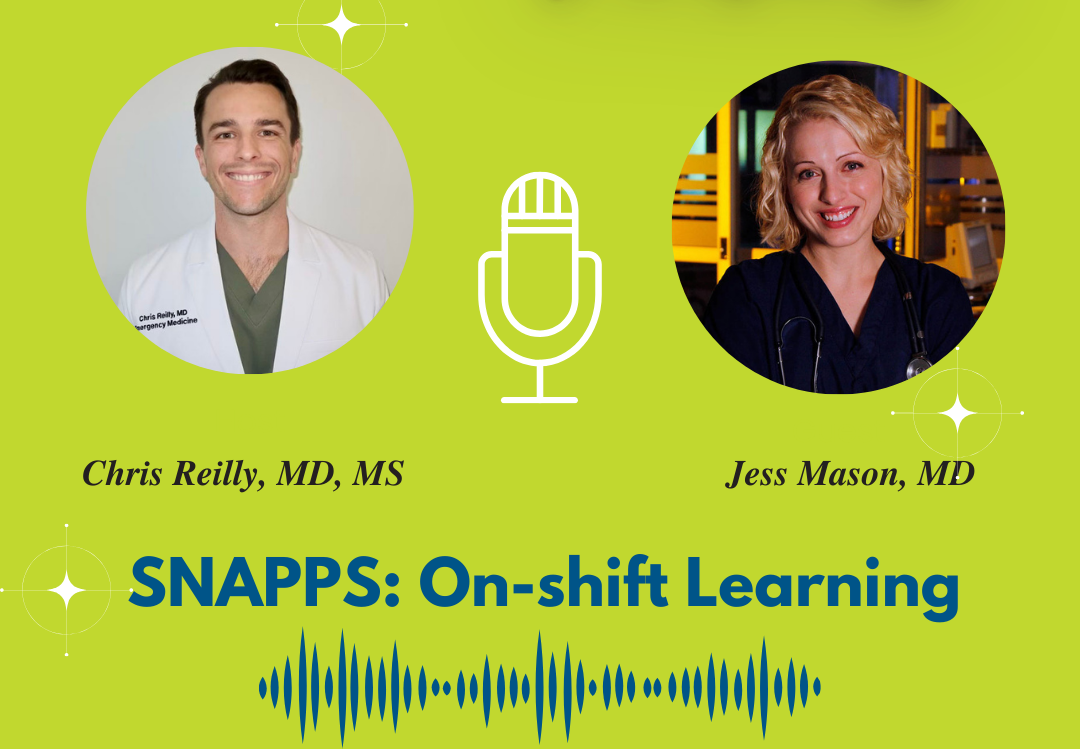SNAPPS: On-Shift Learning with Dr. Jess Mason
SNAPPS: On-Shift Learning (and Teaching) with Dr. Jess Mason
Oct. 18, 2023
"I think we need better on-shift teaching." This is a common quote from residents and med students alike in the emergency department. EMRA*Cast host Chris Reilly, MD, MS, talks with EM:RAP Deputy Director and EM educator Jessica Mason, MD, about different ways residents can take learning into their own hands and get the most out of their on-shift education. It’s as easy as a SNAPPS (punny if you listen).
Host
Christopher Reilly, MD
Maimonides Medical Center Medical Education Fellowship
@docreilles | Instagram: docreilles
EMRA*Cast Episodes
Guest
Jessica Mason, MD
- Associate Clinical Professor of Emergency Medicine, Texas Christian University
- Medical Education Fellowship Director and Core Faculty, JPS Hospital/John Peter Smith Health Network EM Residency
- Deputy Director, EM:RAP: EM:RAP HD videos, and creator of EM:RAP's C3
EMRA 45 Under 45 Influencers in EM
Overview
"I think we need better on-shift teaching." This is a common quote from residents and med students alike in the emergency department. EMRA*Cast host Chris Reilly, MD, MS, talks with EM:RAP queen and Deputy Director Jessica Mason, MD, about different ways residents can take learning into their own hands and get the most out of their on-shift education. It’s as easy as a SNAPPS (punny if you listen).
TAKE-HOME POINTS
- The responsibility of education is a shared responsibility; you must learn to be a good learner.
- "When you are on-shift, think of learning like an investment account. You have to actually invest if you're going to gain anything of value. It's on you."
- You will pick up as many tips from poor educators as from those who inspire you. Remember that as you examine your own role in teaching others on-shift.
- Patient safety/quality care trumps your role as an educator – and it's important to set that expectation for your learners.
- Attention, learners! Use the SNAPPS technique:
- Summarize the history and findings
- Narrow the differential
- Analyze the differential by comparing/contrasting
- Probe the preceptor re: difficulties, questions, etc.
- Plan management for current and potential issues
- Select a case-related issue for self-directed learning
- Recognize the various types of attendings and how to relate to them on the learner/educator level:
- The Teacher: Be vulnerable and seek feedback.
- The Quiet One: Probe using specific questions.
- The No-Autonomy One: Seek to understand this attending's perspective while building trust; probe to reveal the medical decision-making process and learn from it.
- The Absent One: Understand that they're likely looking over your shoulder even when they're silent. Ask for help when you need it so they can engage.
- The Harsh One: As long as it's not abuse, keep it in perspective. You will remember their teaching points – and you'll get the best stories. (See also: "what not to do" examples.)
- Give your attending an assignment at the beginning of the shift. Make it specific so they know exactly what feedback you're seeking.
Resources
- Wolpaw TM, Wolpaw DR. Papp KK. SNAPPS: a learner-centered model for outpatient education. Acad Med. 2003;78(9):893-898. https://pubmed.ncbi.nlm.nih.gov/14507619/
- Chinai SA, Guth T, Lovell E, Epter M. Taking advantage of the teachable moment: A review of learner-centered clinical teaching models. West J Emerg Med. 2018;19(1):28-34. https://www.ncbi.nlm.nih.gov/pmc/articles/PMC5785198/
- Guth TA. EMRA Resident as an Educator: A Guidebook Written by Residents, for Residents. EMRA. 2013. https://www.emra.org/siteassets/emra/publications/books/emra-2013residentaseducator-interactive.pdf
- Sudario G. PV Card: One-Minute Preceptor – NERDS Mnemonic. Academic Life in Emergency Medicine. 2015. https://www.aliem.com/pv-card-one-minute-preceptor-nerds-mnemonic/
- Konda SR, Davidovitch RI, Egol KA. Computed tomography scan to detect traumatic arthrotomies and identify periarticular wounds not requiring surgical intervention: an improvement over the saline load test. J Orthop Trauma. 2013;27(9):498-504. https://pubmed.ncbi.nlm.nih.gov/23287770/#:~:text=Conclusion%3A%20CT%20scan%20performs%20better,in%20the%20appropriate%20clinical%20setting.





